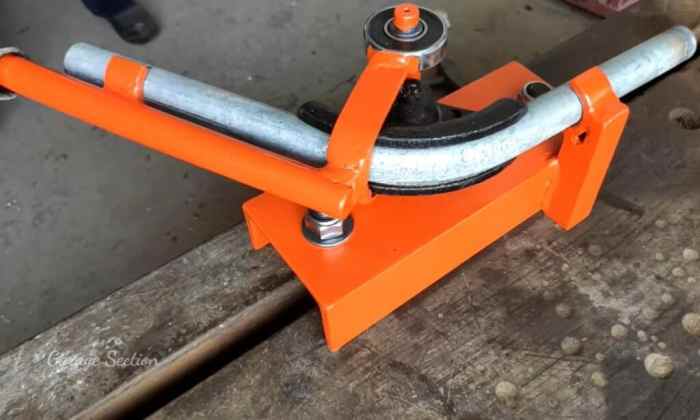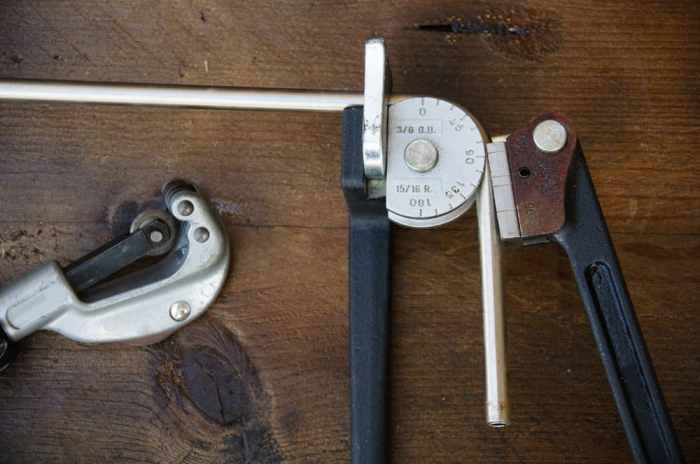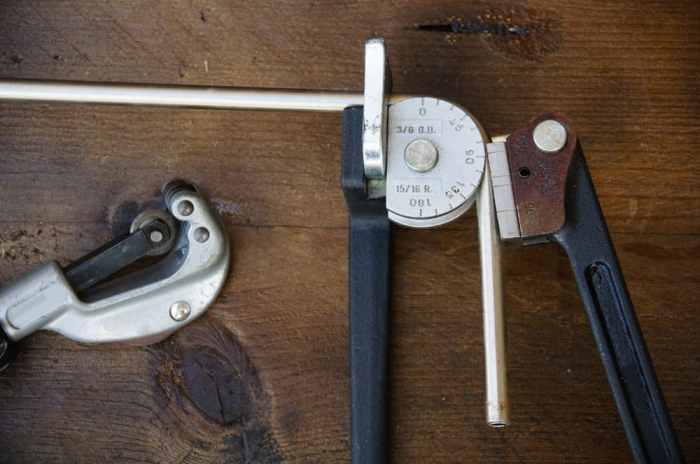DIY pipe bender takes center stage, beckoning readers into a world crafted with good knowledge. Whether you’re a seasoned DIY enthusiast or a curious beginner, this guide will empower you to tackle pipe bending projects with confidence.
From understanding the basics of pipe bending to mastering different techniques and choosing the right tools, we’ll explore the world of DIY pipe bending. Discover how to create stunning furniture, sturdy railings, and intricate decorative elements, all while harnessing the power of this versatile tool.
Introduction to DIY Pipe Benders

Pipe benders are essential tools for shaping metal pipes, a crucial step in various DIY projects. Whether you’re constructing a custom handrail, building a unique furniture piece, or creating a bespoke plumbing system, a pipe bender allows you to achieve the desired curves and angles for your project.
Benefits of DIY Pipe Benders
DIY pipe benders offer several advantages over their professional counterparts, primarily their affordability and versatility. They provide a cost-effective solution for bending pipes in small-scale projects, eliminating the need to invest in expensive professional equipment. Additionally, DIY pipe benders are often more adaptable, allowing for bending various pipe sizes and materials with minimal adjustments.
Common DIY Projects Where Pipe Benders Are Essential
Pipe benders play a crucial role in various DIY projects, adding intricate curves and bends to create unique designs and functionalities. Here are some common applications:
- Handrails: Pipe benders are indispensable for creating custom handrails, allowing you to shape the metal pipe to fit the contours of stairs or balconies. This adds a personalized touch and enhances the aesthetics of your home.
- Furniture: Pipe benders enable the creation of unique furniture pieces, from modern metal chairs to industrial-style coffee tables. The ability to bend pipes allows for intricate designs and structural elements that add character and functionality to your furniture.
- Plumbing: Pipe benders are essential for bending copper or PEX pipes, facilitating efficient and aesthetically pleasing plumbing installations. This includes creating custom bends for water supply lines, drainage systems, and other plumbing fixtures.
- Metal Art: Pipe benders open a world of possibilities for creating metal art, from abstract sculptures to functional wall decor. The ability to bend pipes into various shapes and sizes allows for the creation of unique and eye-catching artistic pieces.
Using a DIY Pipe Bender

A DIY pipe bender is a useful tool for bending pipes for various applications, from plumbing to construction. This guide provides detailed instructions on how to safely and effectively use a DIY pipe bender, including bending pipes of different sizes and materials.
Safety Precautions When Using a DIY Pipe Bender
It is crucial to prioritize safety when using a DIY pipe bender. The following precautions should be observed:
- Wear safety glasses to protect your eyes from flying debris.
- Use gloves to protect your hands from cuts and abrasions.
- Ensure the work area is well-ventilated to prevent the accumulation of harmful fumes.
- Avoid bending pipes near flammable materials or open flames.
- Use a firm and stable work surface to prevent the bender from moving during operation.
- Avoid bending pipes beyond their specified bend radius to prevent cracking or failure.
- Always inspect the pipe for any signs of damage before bending.
- Never attempt to bend pipes that are too large or too thick for the bender’s capacity.
Bending Pipes with a DIY Pipe Bender
Bending pipes with a DIY pipe bender involves a series of steps, ensuring the desired bend is achieved accurately and safely. The steps are:
- Prepare the Pipe: Clean the pipe to remove any dirt or debris that could interfere with the bending process. Ensure the pipe is straight and free of any kinks or dents.
- Set the Bender: Adjust the bender to accommodate the pipe’s diameter and desired bend radius. Ensure the bender is securely clamped to the work surface.
- Position the Pipe: Place the pipe into the bender, ensuring it is properly aligned with the bender’s bending arm.
- Start Bending: Slowly and steadily apply pressure to the bending arm. Avoid applying excessive force to prevent the pipe from kinking or cracking.
- Check the Bend: Periodically check the bend angle to ensure it meets the desired specifications.
- Complete the Bend: Continue applying pressure until the desired bend angle is achieved.
- Release the Pipe: Carefully remove the pipe from the bender, ensuring it is not damaged or bent out of shape.
Bending Pipes of Different Sizes and Materials
The bending process for different pipe sizes and materials may vary.
Bending Different Pipe Sizes
- Smaller Pipes: Smaller pipes can be bent more easily and require less force. Ensure the bender is properly adjusted to accommodate the smaller diameter.
- Larger Pipes: Larger pipes require more force and may need a more robust bender. Use a bender with a higher bending capacity to prevent damage to the pipe.
Bending Different Pipe Materials
- Copper Pipes: Copper pipes are relatively soft and easy to bend. They are commonly used for plumbing and HVAC applications.
- Steel Pipes: Steel pipes are stronger and more durable than copper pipes. They require more force to bend and may need a specialized bender.
- PVC Pipes: PVC pipes are lightweight and flexible. They can be bent using a DIY pipe bender, but it is important to avoid excessive force to prevent cracking.
Troubleshooting and Maintenance
Even the most well-constructed DIY pipe bender can encounter problems, and regular maintenance is crucial for its long-term performance. This section will address common issues and provide solutions, along with tips for keeping your tool in top shape.
Troubleshooting Common Issues
It’s important to identify and address common problems encountered while using a DIY pipe bender to ensure efficient and safe operation.
- Bent Pipe Not Smooth: This often occurs due to uneven pressure application or a poorly aligned bending die. Ensure consistent pressure and that the pipe is properly centered within the die.
- Pipe Crushing or Kinking: Excessive bending force or a die that is too small for the pipe diameter can lead to crushing or kinking. Use the appropriate die size and apply force gradually.
- Bending Die Wear: Over time, the bending die can wear down, leading to inconsistent bends. Inspect the die for wear and replace it as needed.
- Loose or Damaged Components: Regularly check for loose screws, bolts, or damaged components. Tighten loose fasteners and replace damaged parts promptly.
Routine Maintenance
Regular maintenance is essential for extending the lifespan of your DIY pipe bender.
- Cleaning: After each use, clean the bender thoroughly to remove any debris or metal shavings. This helps prevent corrosion and ensures smooth operation.
- Lubrication: Apply a light layer of lubricant to the bending die and other moving parts to reduce friction and wear.
- Inspection: Regularly inspect the bender for any signs of damage, wear, or loose components. Address any issues promptly.
Storage and Handling
Proper storage and handling practices are crucial for protecting your DIY pipe bender.
- Storage: Store the bender in a dry, clean environment to prevent rust and damage.
- Handling: Always handle the bender with care to avoid dropping or damaging it.
Alternatives to DIY Pipe Benders

Sometimes, you may not have the resources or time to build a DIY pipe bender. In such cases, there are alternative methods you can use to bend pipes without relying on a dedicated tool. These methods can be effective for certain projects and situations, but they also have their own limitations. Let’s explore some of these alternatives and their respective advantages and disadvantages.
Using a Pipe Wrench
This method involves using a pipe wrench to manually bend the pipe. It’s a simple technique that can be effective for small bends, especially for pipes with a smaller diameter.
To use a pipe wrench for bending, place the wrench on the pipe at the desired bending point. Apply pressure to the wrench while simultaneously pulling the pipe in the opposite direction.
However, this method is not suitable for large bends or for pipes with a larger diameter, as it can easily damage the pipe.
Using a Hand Bender
Hand benders are specialized tools designed to bend pipes without requiring a dedicated machine. They are typically used for bending pipes with a smaller diameter and are particularly useful for creating tight bends.
Hand benders come in different sizes and designs, depending on the pipe size and the desired bend. Some hand benders use a lever mechanism to apply pressure, while others use a rotating handle.
Hand benders are generally easier to use than DIY pipe benders and can produce more precise bends. However, they can be more expensive and may not be suitable for all pipe sizes.
Using a Hydraulic Bender
Hydraulic benders are powerful tools that use hydraulic pressure to bend pipes. They are typically used for bending larger diameter pipes and can produce very precise bends.
Hydraulic benders come in different sizes and configurations, depending on the size and type of pipe being bent. Some hydraulic benders are portable, while others are stationary.
While hydraulic benders are highly effective, they are also expensive and require specialized skills to operate. They are not typically considered as DIY options.
Using Heat
Heat can be used to soften the pipe material, making it easier to bend. This method is often used for bending copper pipes, as it allows for more flexibility.
To bend a pipe using heat, apply a torch or heat gun to the area where you want to bend the pipe. Once the pipe is heated to the desired temperature, you can bend it manually or using a bending jig.
However, this method requires careful attention to avoid overheating the pipe, which can weaken the material. It is also not suitable for all pipe materials.
Using a Bending Jig
A bending jig is a tool that provides a template for bending pipes. It is often used in conjunction with a hand bender or a hydraulic bender.
Bending jigs come in different shapes and sizes, depending on the desired bend radius and the pipe size. They can be used to create both sharp and gradual bends.
Bending jigs can help to produce more consistent and accurate bends. They are particularly useful for projects that require multiple identical bends.
With the right knowledge, tools, and techniques, DIY pipe bending becomes an accessible and rewarding endeavor. Whether you’re building a custom piece of furniture or adding a touch of industrial charm to your home, the possibilities are endless. Embrace the challenge, unleash your creativity, and enjoy the satisfaction of bending metal to your will.
A DIY pipe bender is a valuable tool for crafting custom metal structures, and it’s especially useful for building a pizza oven. You can use it to bend the metal for the oven’s frame and create a unique shape for your pizza oven. If you’re looking for inspiration for your pizza oven project, check out this pizza oven DIY guide.
Once you’ve mastered bending metal with your DIY pipe bender, the possibilities are endless for creating unique and functional metal structures.

